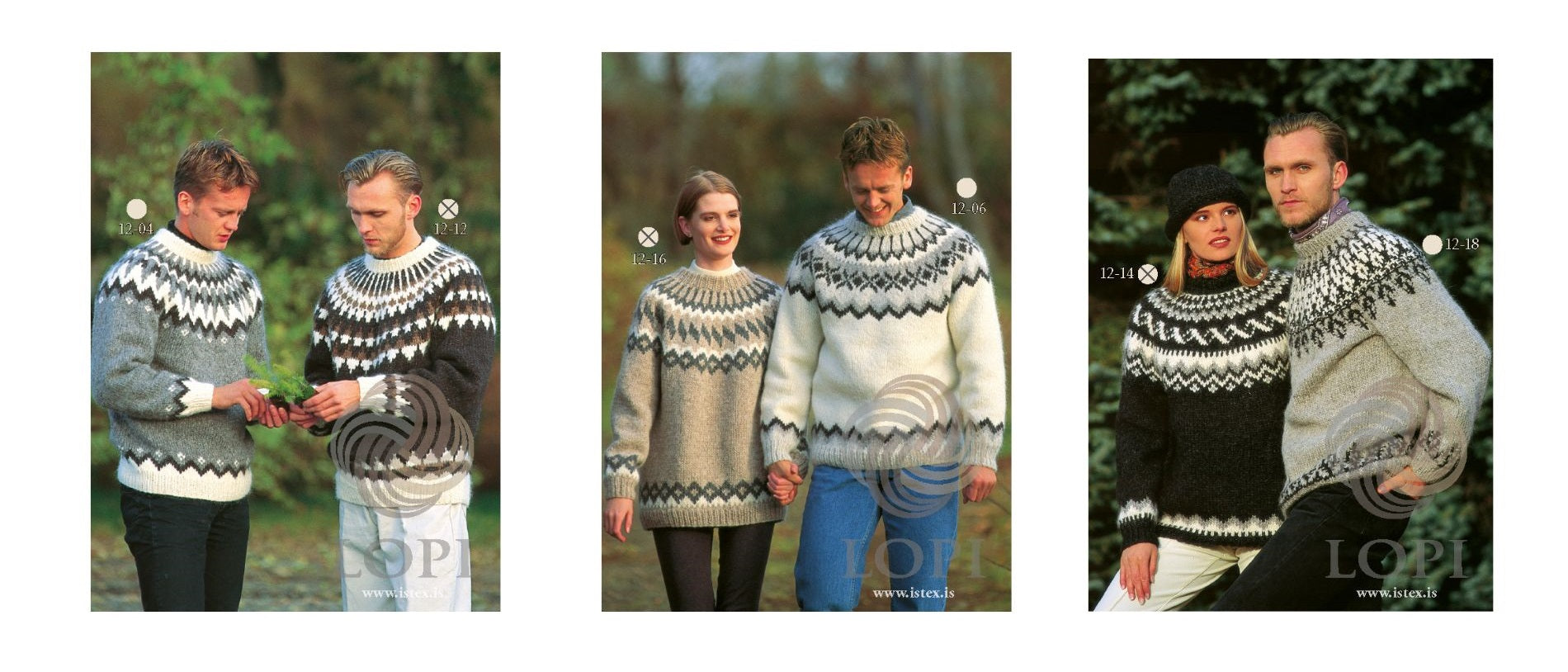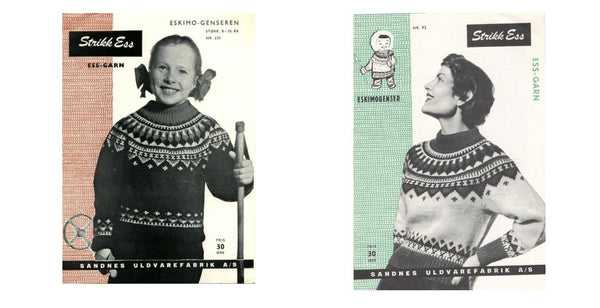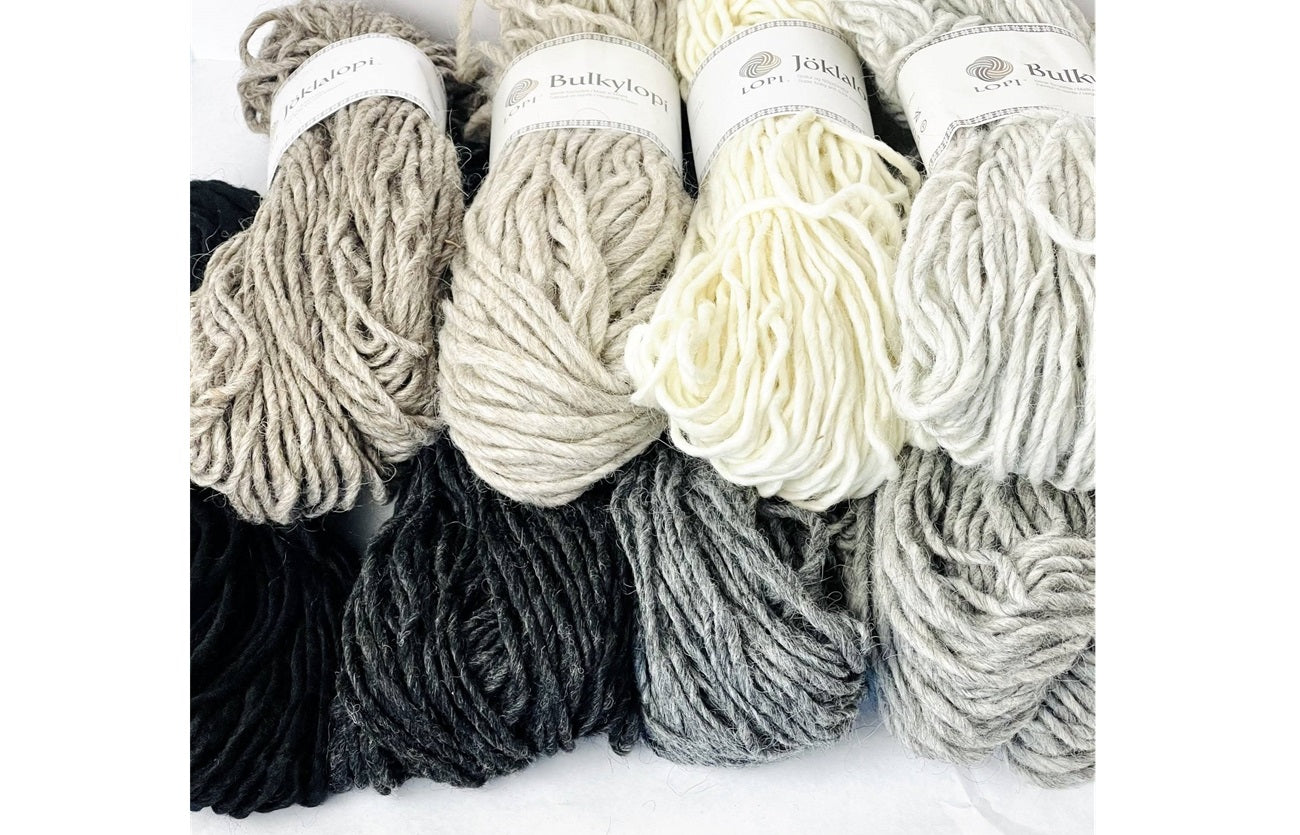
The Origins of the Authentic Icelandic Wool Sweater - Lopapeysa
The Icelandic wool sweater, Lopapeysa, embodies Iceland's rich cultural heritage and traditional knitting practices, dating back to the mid-20th century. Its design journey traverses the Nordic region, weaving together influences from neighboring countries and indigenous Greenlandic attire.
Where did the Icelandic wool sweater come from?
The Icelandic wool sweater, Lopapeysa, stands as a testament to Iceland's vibrant cultural heritage and knitting traditions and is rooted in the rugged landscapes and resilient spirit of the Icelandic people.
While cherished as a symbol of Icelandic tradition, the Lopapeysa design reflects a fascinating journey across the Nordic region, drawing inspiration from the knitting traditions of neighboring countries and indigenous Greenlandic attire. The colorful beaded yoke of the Greenlandic national dress, the nuilarmiut, is belived to have sparked the imagination of knitters in neighboring countries during the 19th century. This admiration led to the publication of a Norwegian sweater pattern in 1932, named "Eskimo" and designed by Annichen S. Bøhn. Inspired by the Nuilarmiut's elaborate yoke, this sweater featured a circular design, a departure from traditional Norwegian seamed sleeves.
The "Eskimo" pattern's journey continued when it was republished in a Danish magazine, eventually reaching the hands of an Icelandic knitter. This encounter sparked the creation of the "Greenland sweater" ("Grænlenzk peysa") in Iceland, featured in a knitting magazine in 1956.

Drawing inspiration from these Nordic influences, Icelandic knitters developed their signature style: the round-yoked sweater made from the distinctive Icelandic wool, Lopi. The thicker Álafosslopi yarn and the circular knitting technique made it quick and easy to knit. Knitting charts initially drew inspiration from existing patterns, but over time, unique and distinctly Icelandic designs emerged.
The Lopapeysa transcended fashion to become a cultural symbol, practically a uniform for Icelanders. Today, the Lopapeysa continues to evolve, blending traditional elements with contemporary flair. The design and construction techniques of the Icelandic sweater have been passed down through generations and are rooted in traditional Icelandic knitting practices, as well as stranded colorwork of two or more colors of yarn are used to create intricate patterns.

What makes an Icelandic sweater, Lopapeysa?
There are several key elements that define an authentic Icelandic sweater. The term "Lopapeysa" is derived from two Icelandic words: "lopi," referring to Icelandic wool, and "peysa," meaning sweater. This unique garment is crafted from the fleece of Icelandic sheep, renowned for its exceptional quality and warmth.
The yarn must be 100% Icelandic wool, in Icelandic called Lopi; respectively Plötulopi, Álafosslopi and Léttlopi. Authentic lopapeysa use new, unspun wool and not recycled wool.
The sweater must be hand-knitted in Iceland by skilled artisans. This ensures quality and adherence to traditional techniques. While modern variations exist, authentic lopapeysa often feature traditional geometric patterns, originally inspired by nature or Icelandic folklore.
One of the defining characteristics of the sweater is the circular yoke, with a circular neckline knitted seamlessly from the top down. This creates a comfortable fit and allows for intricate patterns. The sweater should not have any seams, especially on the shoulders and sleeves.

The patterns are created using stranded colorwork, where two or more yarns are intertwined in each row, creating intricate designs, geometric motifs, traditional patterns, or modern designs.
Lopapeysa is a protected designation of origin in Iceland, ensuring authenticity and quality. While the materials and construction are crucial, the cultural significance and connection to Icelandic heritage are also important aspects. Remember, not all Icelandic wool sweaters are lopapeysa. If you're looking for a genuine piece, look for the above criteria and consider purchasing from reputable Icelandic sources.
- 4 tips on how to store your Icelandic wool sweater
- 12 interesting facts about the Icelandic wool sweater Lopapeysa
How have patterns evolved in the Icelandic sweater over time?
The Lopapeysa, Iceland's iconic sweater, isn't just about cozy wool and eye-catching designs. Its intricate patterns are a deeper story, woven thread by thread with cultural identity, historical echoes, and personal expression.
The evolution of Lopapeysa patterns mirrors shifts in fashion and cultural exchange. The knitting traditions of neighboring nations have left an indelible mark on Lopapeysa patterns. Techniques such as stranded colorwork from Norwegian and Swedish sweaters and seamless construction from Scandinavian knitting, creating a garment that embodies the best of Nordic knitting heritage. Initially inspired by Greenlandic and Norwegian designs, the sweater's aesthetic gradually morphed to embody Iceland's unique knitting traditions. From elaborate circular yokes to simplified contemporary patterns, each iteration reflects adaptation and innovation, showcasing the sweater's enduring appeal.
The patterns is a Tapestry of Heritage, from mountains and snowflakes to lava flows, each motif is a visual ode to Iceland's unique landscape and heritage. The landscape itself whispers stories into the patterns and other natural elements are frequently depicted, reflecting the deep connection between Icelanders and their environment. Motifs drawn from the flora and fauna, like leaves, flowers, and birds, further weave these stories into the fabric.

While tradition provides the foundation, individuality thrives. Knitters add their own flourishes, transforming inherited patterns into personal design. This freedom allows wearers to express their creativity and personality, making each Lopapeysa truly unique. Worn for special occasions, these sweaters become talismans, whispers of hope and tradition woven into the very fabric. Modern interpretations with vibrant colors and new motifs ensure the Lopapeysa remains a living tradition, evolving with the times while keeping the Icelandic spirit alive.
How are patterns in the Icelandic sweater designed?
The Lopapeysa is instantly recognizable by its intricate patterns adorning the yoke and bottom hem. Initially, the sweaters were primarily knitted in the natural colors of Icelandic sheep - white, grey, brown, and black. This, however, changed rapidly with the growing popularity of the sweater. The demand for more diverse designs, wider color options, and different yarn weights spurred yarn manufacturers to expand their offerings to the vibrant range available today.
Designing any knitted garment involves considering various factors: the garment's shape, yarn weight and type, and needle size. With Lopapeysa, additional considerations include the specific type of Lopi wool used and the circular knitting technique, which eliminates seams except for crafting the underarms. Lopi comes in various weights, each yielding distinct results. Finer yarns allow for intricate patterns, while bulkier yarns necessitate simpler designs.
There are different types of Lopi wool and it is used to knit different knitwear:
Bulkylopi: Primarily used for single-colored knitting due to its thickness. See Patterns
Álafosslopi: Favored for outdoor sweaters with simple patterns. See patterns
Léttlopi: Ideal for indoor sweaters with more complex patterns. See patterns
Einband: Creates fine, lace-like garments and elaborate patterns. See patterns
Icelandic Knitting Traditions: Enduring Skills and Techniques
Icelandic knitting techniques have remained remarkably consistent throughout the years. The dominant style is continental knitting, where each hand holds a needle, with the yarn passing between them and intertwined with the left index finger.
The Lopapeysa is built from the bottom up with a simple structure. The circular bottom piece is knitted in rounds. Arms are created using five needles each and then joined seamlessly to the bottom. Following arm attachment, the yoke is knitted with two or more colors using stranded colorwork, gradually decreasing stitches until reaching the desired neckline. Finally, underarm holes are crafted for a seamless finish.
Stranded colorwork, a popular technique in Nordic countries, involves using two or more colors in each row, one at a time. This creates warmer and more durable garments due to the double layering in the patterned areas. The Lopapeysa is knitted in a continuous circle, eliminating the distinction between front and back unless a zipper is added. Even when zippers or buttons are incorporated, the initial knitting process remains the same; the garment is later cut open for closure. To mark the zipper placement, two stitches are purled in the center of the designated area during knitting.
The yoke typically features two to three colors, with a maximum of three colors used per row. This pattern often extends to the hem and sleeves, creating a cohesive design.
Have patterns in the Icelandic sweater changed with modern fashion trends?
While rooted in tradition, Lopapeysa patterns have adapted to modern sensibilities. Contemporary iterations often feature streamlined designs, with a focus on the iconic circular yoke. Despite these changes, the essence of Icelandic craftsmanship remains, ensuring the sweater's enduring appeal in a rapidly evolving fashion landscape.
As Icelandic society evolves, so too does the Lopapeysa, adapting to meet contemporary demands. From its origins as a practical garment for Icelandic farmers to its current status as a symbol of national pride and global fashion, the sweater's journey reflects the resilience of Icelandic culture and its ability to embrace change while staying true to its roots.
In recent years, the Lopapeysa has transcended its cultural origins to become a beloved staple in mainstream fashion. Its timeless charm and unparalleled warmth have endeared it to fashion enthusiasts worldwide, cementing its status as an enduring icon of Icelandic heritage and a testament to the enduring allure of woolen warmth.
Source: Nykänen, L. (2016) Lopapeysa: The significance of patterns in the Icelandic sweater. Bachelor's thesis. Icelandic Academy of the Arts.



Leave a comment
This site is protected by hCaptcha and the hCaptcha Privacy Policy and Terms of Service apply.